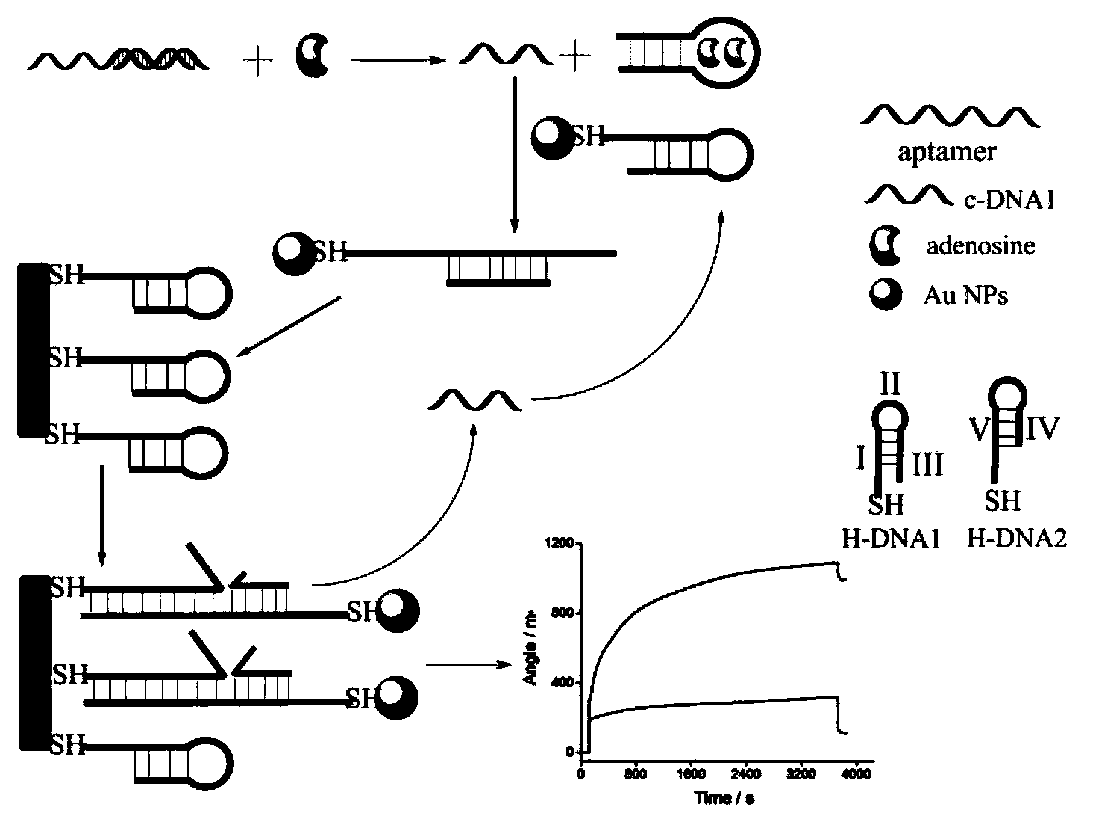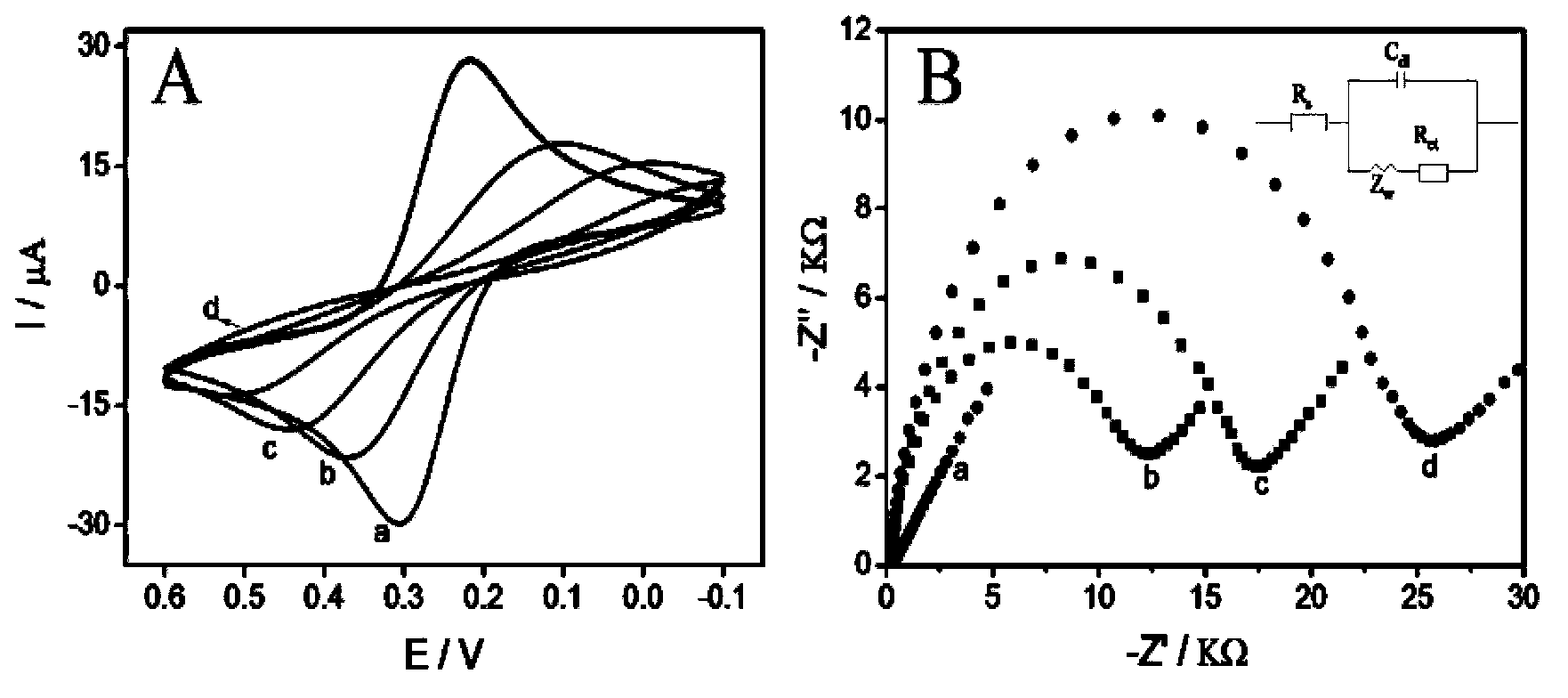Construction and application of aptamer sensor based on Au NPs and DNA circulation double amplification technique
An aptamer sensor and aptamer technology, which can be used in the measurement of scattering properties and other directions to achieve high specificity, good selectivity, and the effect of improving SPR response signals
- Summary
- Abstract
- Description
- Claims
- Application Information
AI Technical Summary
Problems solved by technology
Method used
Image
Examples
Embodiment 1
[0024] (1) Preparation of Au NPs: 50 mL of 0.01% HAuCl 4Add the solution into a 100 mL round-bottomed flask, heat it to boiling, then quickly add 1 mL of trisodium citrate solution with a concentration of 5% by mass under mechanical stirring, continue stirring and keep boiling, and the color of the solution changes from yellow to Stop heating when dark wine red, and naturally cool to room temperature under stirring to obtain stable and monodisperse Au NPs with an average particle size of 13 nm, and store them at 4 °C for later use;
[0025] (2) Preparation of Au NPs-H-DNA1: thiolated H-DNA1 was activated on the column with 100 μL of freshly prepared 1 mM dithiothreitol solution, and mixed with 1 mL of Au NPs solution prepared in step (1), Shake and incubate on a shaker for 12 h, disperse the product in PBS buffer solution, and place at 25 °C for 40 h; centrifuge at 14,000 rpm for 10 min, discard the supernatant, and wash the red oily precipitate with PBS buffer solution after ...
Embodiment 2
[0028] Preparation process of SPR aptasensor
[0029] (1) Place the gold flakes in H with a volume ratio of 7:3 2 SO 4 :H 2 o 2 Soak in the mixed solution for 2 min, rinse with secondary water, immerse in 10 mM mercaptohexanol solution for 2 h, rinse with secondary water and blow dry with nitrogen, then put it into the SPR detection cell. Inject 50 μL, 1.2 μM H-DNA2 solution and react for 2 h to prepare the sensing interface pre-assembled with H-DNA2;
[0030] (2) Incubate 20 μL, 1.0 μM adenosine aptamer and the same ratio of c-DNA1 at 37 °C for 2 h, add 20 μL of adenosine solution of different concentrations, and incubate at 37 °C for 2 h; take 25 Add μL of the above solution to 25 μL Au NPs-H-DNA1 solution, inject the mixed solution into the SPR detection cell to react with the H-DNA2 pre-assembled on the sensing interface for 1 h; use a peristaltic pump to discharge the reaction solution And inject 50 μL of secondary water for cleaning;
[0031] The preparation proces...
Embodiment 3
[0033] Detection of Adenosine by SPR Aptamer Sensor
[0034] (1) Optimization of strand replacement cycle time, H-DNA2 concentration, and H-DNA1 concentration
[0035] Figure 4 A is the SPR response of the sensor to 50 pM and 0 pM adenosine at different chain replacement cycle reaction times. It can be seen from the figure that for 50 pM adenosine, the intensity of the SPR response increases with the prolongation of the strand replacement cycle reaction time, and tends to be stable after 1 h; when there is no adenosine, the SPR response intensity increases with the prolongation of the reaction time The intensity increases slightly accordingly. Therefore, the selection strand replacement cycle reaction was 1 h. Figure 4 B is the effect of H-DNA2 concentration on the SPR sensing response. When the concentration of H-DNA2 was 1.2 μM, the signal-to-noise ratio of the sensor was optimal, further increasing the concentration of H-DNA2, the SPR response decreased slightly, whic...
PUM
| Property | Measurement | Unit |
|---|---|---|
| Particle size | aaaaa | aaaaa |
Abstract
Description
Claims
Application Information
 Login to view more
Login to view more - R&D Engineer
- R&D Manager
- IP Professional
- Industry Leading Data Capabilities
- Powerful AI technology
- Patent DNA Extraction
Browse by: Latest US Patents, China's latest patents, Technical Efficacy Thesaurus, Application Domain, Technology Topic.
© 2024 PatSnap. All rights reserved.Legal|Privacy policy|Modern Slavery Act Transparency Statement|Sitemap



